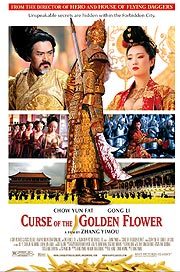Children of Men
 Although Children of Men is centered around the tired idea of a dreary dystopian future, director Alfonso Cuaron has taken an entirely refreshing and amazing approach that will reaffirm your belief in the art of filmmaking. Adapted from a novel of the same name by P.D. James, the film presents the chilling concept of a near-future world where the entire population is infertile. No children have been born in over 18 years, and the adults have lost hope for themselves and their communities. The population stumbles through their daily routines in a rapidly disintegrating infrastructure littered with slums, abandoned schools, and fading dreams.
Although Children of Men is centered around the tired idea of a dreary dystopian future, director Alfonso Cuaron has taken an entirely refreshing and amazing approach that will reaffirm your belief in the art of filmmaking. Adapted from a novel of the same name by P.D. James, the film presents the chilling concept of a near-future world where the entire population is infertile. No children have been born in over 18 years, and the adults have lost hope for themselves and their communities. The population stumbles through their daily routines in a rapidly disintegrating infrastructure littered with slums, abandoned schools, and fading dreams.Clive Owen stars as Theodore Faron, a former activist who has settled into a mundane and secure existence as a cog in a corporate machine. Like most of the population, he drifts through life without any joy or purpose, just taking one day at a time as the clock slowly winds down on the entire human race. He had a child once with his long-ago girlfriend, but lost both of them when the child died. When the girlfriend re-enters his life with a surprising proposition, he’s faced with the decision about whether to remain in his comfort zone or assist her with her dangerous request. Eventually, he chooses to help her transport a refugee woman to a safe destination. He later learns that the woman is miraculously pregnant and expecting delivery within days.
England has become a wasteland, with trash piling up in the streets, deteriorating mass transit vehicles, and crumbling buildings. This bleak society is one of Cuaron’s primary accomplishments, as the production design seems so real that viewers don’t have to make any leap of the imagination to buy the concept. There are a few minor nods to technological advancement, mostly through the use of video billboards and slightly different vehicles, but the tech never detracts from the believability of the environments. Cars look like real production models covered in grime, fashion hasn’t gone off on any wild tangents, and there aren’t any hovercrafts or other futuristic toys to distract viewers. Cuaron’s London isn’t too different from today’s reality, making the film seem chillingly possible rather than absurdly abstract.
The movie’s acting duties rest firmly on Owen’s shoulders, but he’s backed up by a superb supporting cast including Julianne Moore, Michael Caine, and Chiwetel Ejiofor. Moore’s role is far smaller than expected, making her exit all the more surprising and powerful. Caine gets the most mileage out of his brief role as an aging, slightly comical hippie, seemingly relishing the chance to play against his usual reserved type. Ejiofor isn’t given much material in his role as an activist leader, but contributes a fairly solid performance.
Another one of Cuaron’s key accomplishments is the bravura camerawork throughout the film. He could have settled for standard camera setups with multi-angle coverage and cuts, but instead designed some fascinating one-take scenes that will be studied in film schools for decades to come. One scene finds the protagonists traveling by car until they encounter an angry mob and quickly retreat in reverse gear, which doesn’t sound all that special except that the camera appears to be in the car, constantly moving from passenger to passenger to capture their dialogue at the right times as well as all of the action outside of the car. Every seat in the car was occupied, leaving even less room for maneuverability and more room for amazement. It’s reminiscent of a similar scene in War of the Worlds, but seemingly more real and thus more impressive.
The showcase one-take scene finds Owen and his compatriots struggling through a warzone as violence erupts all around them, including their temporary apprehension by pursuers, their harrowing separation, and Owen’s valiant effort to find his way back to them as he enters and climbs a building teeming with refugees under fire from military tanks. Blood gets splattered on the lens near the latter part of the lengthy run and stays there, enforcing the concept that we’re right there in the thick of things. Like this scene, much of the film was shot with handheld cameras, giving it an immediacy that forcefully involves the audience. The camerawork is completely stunning and worth the price of admission alone, but thankfully the story supports the effort as well.
The script defies expectations at every turn. Long-lost loves usually lead to rekindled flames, but this reconciliation takes a surprising turn. Good guys become bad guys, keeping us off-balance as we try to determine the resolution. The protagonist doesn’t spend time bemoaning his past to gain our sympathy, doesn’t befriend anyone or have any emotional breakthroughs. The final goal is clearly stated, but its resulting outcome isn’t explicitly defined. In short, there’s enough ambiguity and peripheral information that the overarching story feels like glorious, messy reality rather than sterile, linear fiction.
High concepts have a high probability of misfire, but Cuaron has perfected his vision of the future by focusing entirely on the reality rather than the fantasy. In turn, he has delivered a captivating, thrilling tale that transcends its source material and approaches instant classic status.
Labels: Alfonso Cuaron, Children of Men, Clive Owen, Julianne Moore, Michael Caine






